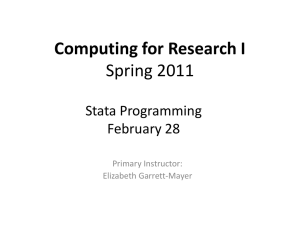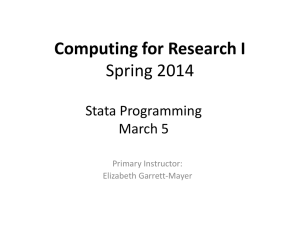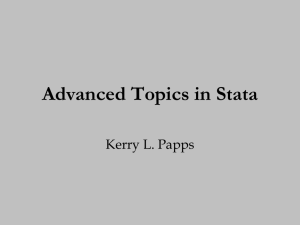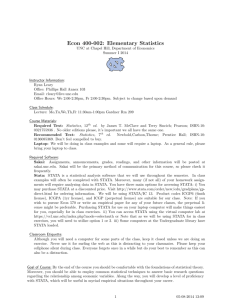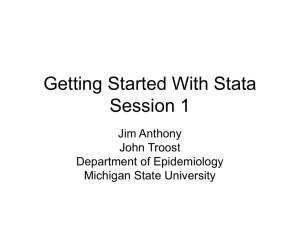Some advanced Stata notes - Personal Homepages for the
advertisement
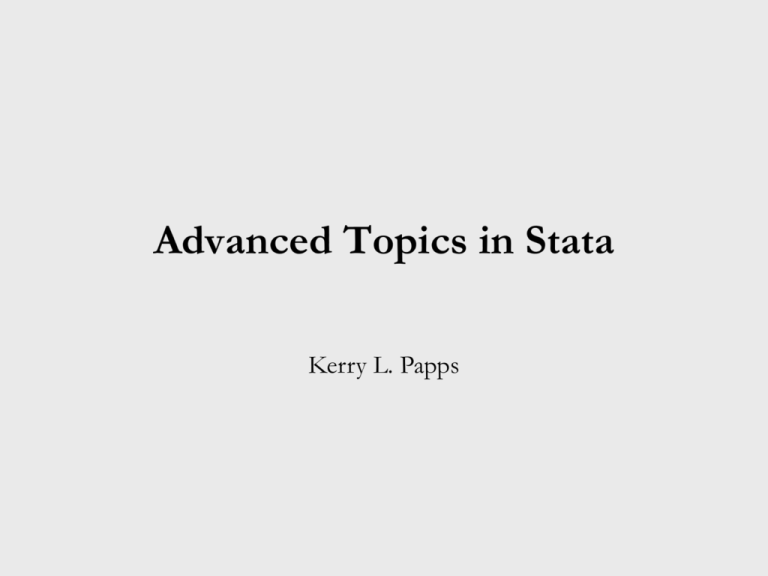
Advanced Topics in Stata
Kerry L. Papps
1. Overview
• Basic commands for writing do-files
• Accessing automatically-saved results generated by Stata
commands
• Matrices
• Macros
• Loops
• Writing programmes
• Ado-files
2. Comment on notation used
• Consider the following syntax description:
list [varlist] [in range]
– Text in typewriter-style font should be typed
exactly as it appears (although there are possibilities for
abbreviation).
– Italicised text should be replaced by desired variable
names etc.
– Square brackets (i.e. []) enclose optional Stata
commands (do not actually type these).
• This notation is consistent with notation in Stata Help
menu and manuals.
3. Writing do-files
• These commands are normally used in Stata do-files
(although most can also be used interactively).
• We will write do-files in the Stata do-file editor. (Go to
Window Do-File Editor or click .)
• Type each line of code on a new line of the do-file.
• Alternatively, to use a semi-colon (;) as the command
delimiter, start the do-file with the command:
#delimit ;
• This allows multiple-line commands. To return to using the
Return key at the end of each line, type:
#delimit cr
4. Writing do-files (cont.)
• To prevent Stata from pausing each time the Results
window is full of output, type:
set more off
• To execute a do-file without presenting the results of any
output, use:
run dofilename
• To execute any Stata command while suppressing the
output, use:
quietly command
5. Types of Stata commands
• Stata commands (and new commands that you and others
write) can be classified as follows:
– r-class: General commands such as summarize.
Results are returned in r() and generally must be used
before executing more commands.
– e-class: Estimation commands such as regress,
logistic etc., that fit statistical models. Results are
returned in e() and remain there until the next model
is estimated.
– s-class: Programming commands that assist in parsing.
These commands are relatively rare. Results are
returned in s().
6. Types of Stata commands
(cont.)
– n-class: Commands that do not save results at all, such
as generate and replace.
– c-class: Values of system parameters and settings and
certain constants, such as the value of π, which are
contained in c().
7. Accessing returned values
• return list, ereturn list, sreturn list and
creturn list return all the values contained in the
r(), e(), s() and c() vectors, respectively.
• For example, after using summarize, r() will contain
r(N), r(mean), r(sd), r(sum) etc.
• Elements of each of the vectors can be used when creating
new variables. They can also be saved as macros (see later
section).
• e(sample) is a useful function that records the
observations used in the most recent model, e.g.:
summarize varlist if e(sample)==1
8. Accessing returned values
(cont.)
• Although coefficients and standard errors from the most
recent model are saved in e(), it is quicker to refer to
them by using _b[varname] and _se[varname],
respectively.
• For example:
gen fitvals = educ*_b[educ] +
_cons*_b[_cons]
EXERCISE 1
9. Regression results
• Note that all solutions to the exercises are contained in:
http://people.bath.ac.uk/klp33/advanced_
stata.do
• Start a do-file and change the working directory to a folder
of your choice (myfolder) using:
cd c:\myfolder
• Open (with use) the file:
http://people.bath.ac.uk/klp33/advanced_
stata_data.dta
EXERCISE 1 (cont.)
10. Regression results
• Create the total crime rate (totcrimerate),
imprisonment rate (imprisrate) and execution rate
(execrate) by dividing totcrime, impris and
exec, respectively, by population and multiplying by
100,000.
• Create the unemployment rate (unemplrate) by
dividing unempl by lf and multiplying by 100.
• Create youthperc by dividing youthpop by
population and multiplying by 100.
• Create year2 by squaring year.
• Regress totcrimerate on inc, unemplrate,
imprisrate, execrate, youthperc, year and
year2.
EXERCISE 1 (cont.)
11. Regression results
• Look at the results that are saved in e() by using:
ereturn list
• Create a variable that measures the (quadratic) trend in
crime:
gen trend = _b[year]*year +
_b[year2]*year2
• Plot this against time by using:
scatter trend year
• Save the modified dataset as “Crime data”.
12. Creating matrices
• In addition to the following, a complete matrix language,
Mata, is incorporated in Stata.
• Matrices are not stored in the spreadsheet.
• Matrices can be inputted manually using:
matrix [input] matname = (#[,#…][\
#[,#…][\[…]]])
1 2
type:
• For example, to create A
3 4
matrix A = (1,2 \ 3,4)
13. Creating matrices (cont.)
• To create a matrix with existing variables as columns,
type:
mkmat varlist[, matrix(matname)]
• If the matrix option is omitted, the variables in varlist will
be stored as separate column vectors with the same names
as the variables.
• To create new matrices from existing matrices:
matrix [define] matname = exp
14. Matrix operators and
functions
• Some operators and functions that may be used in exp:
– + means addition
– - means subtraction or negation
– * means multiplication
– / means matrix division by a scalar
– ’ means transpose
– # means Kronecker product
– inv(matname) gives the inverse of matname
15. Submatrices
• To obtain submatrices, type:
matrix newmat = oldmat[rowrange, colrange]
• rowrange and colrange can be single numbers or ranges
with start and finish positions separated by two periods.
• For example, to create a matrix B containing the second
through fourth rows and first through fifth columns of A,
type:
matrix B = A[2..4,1..5]
• To take all rows after the second, use three periods:
matrix B = A[2...,1..5]
16. Cross-product matrices
• To create cross-product matrices (X’X) it is convenient to
use the following code:
matrix accum matname = varlist[,
noconstant]
• A constant will be added unless noconstant is
specified.
• For example, matrix accum XX = age educ
would create a 3×3 matrix of cross-products.
17. Managing matrices
• To list a matrix, type:
matrix list matname
• To rename a matrix, type:
matrix rename oldname newname
• To drop one or more matrices, type:
matrix drop [matlist]
EXERCISE 2
18. Regression with matrices
• Start a new do-file and open “Crime data.dta”.
• Suppose we wanted to perform the regression from
Exercise 1 manually. Calculate the estimated coefficient
vector: b = (X′X)-1X′y.
• To do this, first construct a general cross-product matrix Z
by typing:
matrix accum Z = totcrimerate inc
unemplrate imprisrate execrate
youthperc year year2
• Display Z using matrix list.
EXERCISE 2 (cont.)
19. Regression with matrices
• Next, construct the matrix X′X by selecting all but the first
row and column of Z and save it as XX.
• Construct X′y by selecting only the first column of Z
below the first row and save it as Xy.
• Construct the vector b using the matrix command, the
inv() function and the matrices XX and Xy.
• Display the contents of b using matrix list and verify
that the coefficients are the same as those generated by
regress in Exercise 1 (within acceptable rounding error
limits).
• Save your do-file in the working directory.
20. Macros
• A macro is a string of characters (the macro name) that
stands for another string of characters (the macro
contents).
• Macros allow you to avoid unnecessary repetition in your
code.
• More importantly, they are also the variables (or “building
blocks”) of Stata programmes.
• Macros are classified as either global or local.
21. Macro assignment
• Global macros exist for the remainder of the Stata session
and are defined using:
global gblname [exp]
• Local macros exist solely within a particular programme or
do-file:
local lclname [exp]
• When exp is enclosed in double quotes, it is treated as a
string; when exp begins with =, it is evaluated as an
expression.
22. Macro assignment (cont.)
• For example, consider:
local problem “2+2”
local solution = 2+2
• problem contains 2+2, solution contains 4.
23. Referring to macros
• To substitute the contents of a global macro, type the
macro name preceded by $.
• To substitute the contents of a local macro, type the macro
name enclosed in single quotes (`’).
• For example, the following are all equivalent once
gblname and lclname have been defined as newvar using
global and local, respectively:
gen newvar = oldvar
gen $gblname = oldvar
gen `lclname’ = oldvar
24. Temporary variables
• tempvar creates a local macro with a name different to
that of any variable. This can then be used to define a new
variable. For example:
tempvar sumsq
gen `sumsq’ = var1^2 + var2^2
• Temporary variables are dropped as soon as a programme
terminates.
• Similarly, it is possible to define temporary files.
25. Manipulating macros
• macro list displays the names and contents of all
defined macros.
• Note that local macros are stored with an underscore (_) at
the beginning of their names.
• When working with multiple folders, global macros can be
used to avoid typing full file names, e.g.:
global mypath “c:\Stata files”
use “$mypath\My Stata data”
26. Looping over items
• The foreach command allows one to repeat a sequence
of commands over a set of variables:
foreach lclname of listtype list {
Stata commands referring to `lclname’
}
• Stata repeatedly sets lclname equal to each element in list
and executes the commands enclosed in braces.
• lclname is a local macro, so should be enclosed in single
quotes when referred to within the braces.
• listtype may be: local, global, varlist, newlist,
numlist.
27. Looping over items (cont.)
• With local and global, list should already be defined
as a macro. For example:
local listname “age educ inc”
foreach var of local listname {
• With varlist, newlist and numlist, the actual list
is written in the foreach line, e.g.:
foreach var of varlist age educ inc {
• foreach may also be used with mixed lists of variable
names, numbers, strings etc.:
foreach x in educ 5.8 a b inc {
• You can nest any number of foreach loops (with unique
local names) within each other.
28. Looping over values
• To loop over consecutive values, use:
forvalues lclname = range {
• For example, to loop from 1 to 1000 in steps of 1, use:
forvalues i = 1/1000 {
• To loop from 1 to 1000 in steps of 2, use:
forvalues i = 1(2)1000 {
• This is quicker than foreach with numlist for a large
number of regularly-spaced values.
29. More complex loops
• while allows one to repeat a series of commands as long
as a particular restriction is true:
while exp {
Stata commands
}
• For example:
local i “7 6 5 4 3 2 1”
while `i’>4 {
• This will only set `i’ equal to 7, 6 and 5.
• Sometimes it is useful to refer to elements by their position
in the list (“token”). This can be done with tokenize:
tokenize string
30. More complex loops (cont.)
• string can be a macro or a list of words.
• `1’ will contain the first list item, `2’ the second item
and so on, e.g.:
local listname “age educ inc”
tokenize `listname’
• `1’ will contain age, `2’ educ and `3’ inc.
• To work through each item in the list one at a time, use
macro shift at the end of a loop, e.g.:
while “`1’” ~= “” {
Commands using `1’
macro shift
}
31. More complex loops (cont.)
• At each repetition, this will discard the contents of `1’,
shift `2’ to `1’, `3’ to `2’ and so on.
• Where possible, use foreach instead of while.
EXERCISE 3
32. Using loops in regression
• Use foreach with varlist to create a loop that
generates the rate per 100,000 people for each crime
category and names the new variables by adding “rate” to
the end of the old variable names.
• Save the updated dataset.
• Use forvalues to create a loop that repeats the
regression from Exercise 1 (minus imprisrate)
separately for observations with imprisonment rates in
each interval of 50 between 0 and 250.
• Hint: use an if restriction with the regression after starting
with the following line:
forvalues i = 50(50)250 {
33. Writing programmes
• To create your own Stata commands that can be executed
repeatedly during a session, use the program command:
program progname
args arg1 arg2…
Commands using `arg1’, `arg2’ etc.
end
• args refers to the words that appear after progname
whenever the programme is executed.
34. Writing programmes (cont.)
• For example, you could write a (pointless) programme that
added two numbers together:
program mysum
args a b
local c = `a’+`b’
display `c’
end
• Following this, mysum followed by two numbers can be
used just like any other Stata command.
• For example, typing mysum 3 9 would return the
output 12.
35. Writing programmes (cont.)
• If the number of arguments varies, use syntax instead of
args.
• syntax stores all arguments in a single local macro.
• For example, to add any number of numbers together, use
the following code (anything is one of three available
format options):
36. Writing programmes (cont.)
program mysum
syntax anything
local c = 0
foreach num of local anything {
local c = `c’+`num’
}
display `c’
end
37. Writing programmes (cont.)
• To list all current programmes, type:
program dir
• To drop a previously-defined programme, use:
program drop progname
• By default, Stata does not display the individual lines of
your programme as it executes them, however to debug a
programme, it is useful to do so, using set trace on.
• set trace off undoes this command.
EXERCISE 4
38. Creating a programme
• Take the code that created the estimated coefficient vector
b from Exercise 2 and turn it into a Stata programme
called myreg that regresses any dependent variable on the
set of 7 independent variables used.
• You should be able to invoke myreg by typing myreg
depvarname.
• Hint: Use args depvar to create a macro called
depvar and use this instead of totcrimerate in the
existing code.
• Make sure that the b vector is displayed by the programme
by using matrix list b.
EXERCISE 4 (cont.)
39. Creating a programme
• Check that myreg gives the same results as regress
when a couple of different crime categories are used as the
dependent variable.
40. Ado-files
• An ado-file (“automatic do-file”) is a do-file that defines a
Stata command. It has the file extension .ado.
• Not all Stata commands are defined by ado-files: some are
built-in commands.
• The difference between a do-file and an ado-file is that
when the name of the latter is typed as a Stata command,
Stata will search for and run that file.
• For example, the programme mysum could be saved in
mysum.ado and used in future sessions.
• Ado-files often have help (.hlp) files associated with them.
41. Ado-files (cont.)
• There are three main sources of ado-files:
– Official updates from StataCorp.
– User-written additions (e.g. from the Stata Journal).
– Ado-files that you have written yourself.
• Stata stores these in different locations, which can be
reviewed by typing sysdir.
• Official updates are saved in the folder associated with
UPDATES.
• User-written additions are saved in the folder associated
with PLUS.
• Ado-files written by yourself should be saved in the folder
associated with PERSONAL.
42. Installing ado-files
• If you have an Internet connection, official updates and
user-written ado-files can be installed easily.
• To install official updates, type:
update from http://www.stata.com
• Next, follow the recommendations in the Results window.
• Users on the University network should not need to do this
as Stata is regularly updated.
• To install a specific user-written addition, type:
net from http://www.stata.com
• Next, click on one of the listed options and follow the links
to locate the required file.
43. Installing ado-files (cont.)
• To search for an ado-file with an unknown name and
location, type:
net search keywords
• Equivalently, go to Help Search and click “Search net
resources”.
• For example, estout.ado is a very convenient userwritten ado-file that saves Stata regression output in a form
that can be displayed in academic tables.
• Since network users do not have generally have access to
the c:\ drive, they must first choose another location in
which to save additional ado-files:
sysdir set PLUS yourfoldername
44. Installing ado-files (cont.)
• Finally, to add an ado-file of your own, simply write the
code defining a programme and save the file with the same
name as the programme and the extension .ado in the
folder associated with PERSONAL.
• Once again, network users will have to change the location
of this folder with:
sysdir set PERSONAL yourfoldername

